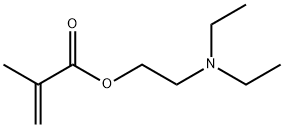2-(Diethylamino)ethyl methacrylate
Synonym(s):β-(Diethylamino)ethyl methacrylate;2-(N ,N -Diethylamino)ethyl methacrylate
- CAS NO.:105-16-8
- Empirical Formula: C10H19NO2
- Molecular Weight: 185.26
- MDL number: MFCD00038314
- EINECS: 203-275-7
- SAFETY DATA SHEET (SDS)
- Update Date: 2024-12-18 14:08:52

What is 2-(Diethylamino)ethyl methacrylate?
Chemical properties
Colorless liquid
Physical properties
The pKa of (Diethylamino)ethyl methacrylate (DEAEMA) monomers is 8.8, while the pKa of these corresponding homopolymers is 7.5[1].
The Uses of 2-(Diethylamino)ethyl methacrylate
2-(Diethylamino)ethyl Methacrylate is used in preparation method and application of Hydrogel assembled self-adhesive material.
General Description
A clear light colored liquid. Insoluble in water and slightly denser than water. Flash point between 100-141°F. May be toxic by ingestion. Contact may severely irritate skin.
Air & Water Reactions
Flammable. Insoluble in water.
Reactivity Profile
An acrylic acid ester/amine. Esters react with acids to liberate heat along with alcohols and acids. Strong oxidizing acids may cause a vigorous reaction that is sufficiently exothermic to ignite the reaction products. Heat is also generated by the interaction of esters with caustic solutions. Flammable hydrogen is generated by mixing esters with alkali metals and hydrides. Amines are chemical bases. They neutralize acids to form salts plus water. These acid-base reactions are exothermic. The amount of heat that is evolved per mole of amine in a neutralization is largely independent of the strength of the amine as a base. Amines may be incompatible with isocyanates, halogenated organics, peroxides, phenols (acidic), epoxides, anhydrides, and acid halides. Flammable gaseous hydrogen is generated by amines in combination with strong reducing agents, such as hydrides.
Health Hazard
Inhalation or contact with material may irritate or burn skin and eyes. Fire may produce irritating, corrosive and/or toxic gases. Vapors may cause dizziness or suffocation. Runoff from fire control or dilution water may cause pollution.
Flammability and Explosibility
Non flammable
References
[1] Ali Darabi. “Nitroxide-Mediated Polymerization of 2-(Diethylamino)ethyl Methacrylate (DEAEMA) in Water.” Macromolecules 48 1 (2014): 72–80.
Properties of 2-(Diethylamino)ethyl methacrylate
| Melting point: | -60°C |
| Boiling point: | 80 °C10 mm Hg(lit.) |
| Density | 0.922 g/mL at 25 °C(lit.) |
| vapor pressure | 11Pa at 20℃ |
| refractive index | n |
| Flash point: | 170 °F |
| storage temp. | Sealed in dry,Room Temperature |
| form | clear liquid |
| pka | 9.18±0.25(Predicted) |
| color | Colorless to Almost colorless |
| Decomposition | 176-178 ºC |
| CAS DataBase Reference | 105-16-8(CAS DataBase Reference) |
| NIST Chemistry Reference | Diethylaminoethyl methacrylate(105-16-8) |
| EPA Substance Registry System | 2-(Diethylamino)ethyl methacrylate (105-16-8) |
Safety information for 2-(Diethylamino)ethyl methacrylate
| Signal word | Warning |
| Pictogram(s) |
 Exclamation Mark Irritant GHS07 |
| GHS Hazard Statements |
H315:Skin corrosion/irritation H317:Sensitisation, Skin H319:Serious eye damage/eye irritation H332:Acute toxicity,inhalation |
| Precautionary Statement Codes |
P261:Avoid breathing dust/fume/gas/mist/vapours/spray. P264:Wash hands thoroughly after handling. P264:Wash skin thouroughly after handling. P280:Wear protective gloves/protective clothing/eye protection/face protection. P302+P352:IF ON SKIN: wash with plenty of soap and water. P305+P351+P338:IF IN EYES: Rinse cautiously with water for several minutes. Remove contact lenses, if present and easy to do. Continuerinsing. |
Computed Descriptors for 2-(Diethylamino)ethyl methacrylate
| InChIKey | SJIXRGNQPBQWMK-UHFFFAOYSA-N |
New Products
(S)-3-Aminobutanenitrile hydrochloride 4-Methylphenylacetic acid N-Boc-D-alaninol N-BOC-D/L-ALANINOL Tert-butyl bis(2-chloroethyl)carbamate 3-Morpholino-1-(4-nitrophenyl)-5,6-dihydropyridin- 2(1H)-one Furan-2,5-Dicarboxylic Acid Tropic acid 1-Bromo-3,5-Di-Tert-Butylbenzene S-2-CHLORO PROPIONIC ACID ETHYL ISOCYANOACETATE 2-Bromo-1,3-Bis(Dimethylamino)Trimethinium Hexafluorophosphate 4-IODO BENZOIC ACID 3-NITRO-2-METHYL ANILINE 1-(2,4-DICHLOROPHENYL) ETHANAMINE (2-Hydroxyphenyl)acetonitrile 4-Bromopyrazole 2-(Cyanocyclohexyl)acetic acid 4-methoxy-3,5-dinitropyridine 1-(4-(aminomethyl)benzyl)urea hydrochloride 2-aminopropyl benzoate hydrochloride diethyl 2-(2-((tertbutoxycarbonyl)amino) ethyl)malonate tert-butyl 4- (ureidomethyl)benzylcarbamate Ethyl-2-chloro((4-methoxyphenyl)hydrazono)acetateRelated products of tetrahydrofuran








You may like
-
 2-(Diethylamino)ethyl methacrylate, 99% CAS 105-16-8View Details
2-(Diethylamino)ethyl methacrylate, 99% CAS 105-16-8View Details
105-16-8 -
 2-(Diethylamino)ethyl Methacrylate (stabilized with MEHQ) CAS 105-16-8View Details
2-(Diethylamino)ethyl Methacrylate (stabilized with MEHQ) CAS 105-16-8View Details
105-16-8 -
 2-(Diethylamino)ethyl methacrylate CAS 105-16-8View Details
2-(Diethylamino)ethyl methacrylate CAS 105-16-8View Details
105-16-8 -
 1975-50-4 98%View Details
1975-50-4 98%View Details
1975-50-4 -
 2-HYDROXY BENZYL ALCOHOL 98%View Details
2-HYDROXY BENZYL ALCOHOL 98%View Details
90-01-7 -
 2-Chloro-1,3-Bis(Dimethylamino)Trimethinium Hexafluorophosphate 221615-75-4 98%View Details
2-Chloro-1,3-Bis(Dimethylamino)Trimethinium Hexafluorophosphate 221615-75-4 98%View Details
221615-75-4 -
 14714-50-2 (2-Hydroxyphenyl)acetonitrile 98+View Details
14714-50-2 (2-Hydroxyphenyl)acetonitrile 98+View Details
14714-50-2 -
 118753-70-1 98+View Details
118753-70-1 98+View Details
118753-70-1